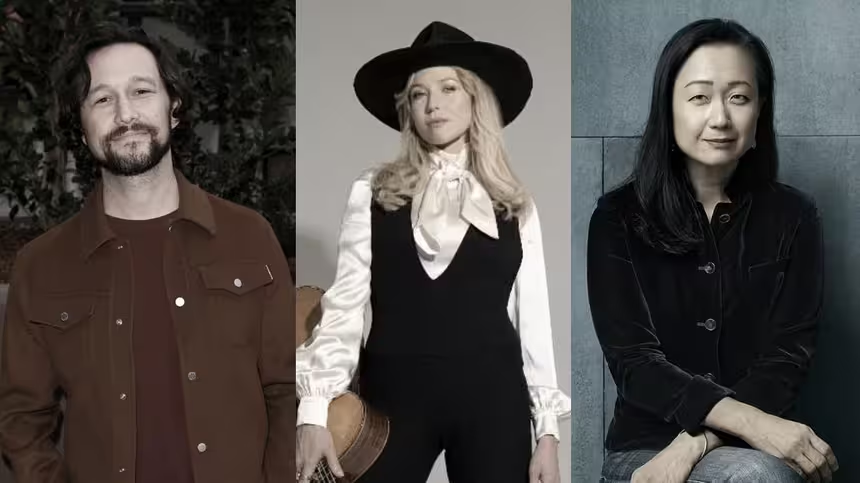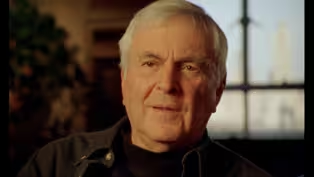
I. M. Pei on sculpture
Special | 7m 26sVideo has Closed Captions
I. M. Pei shares his thoughts on the relationship between sculpture and scale.
On July 24, 1997, architect I. M. Pei shared his thoughts on the relationship between sculpture and scale, including why abstract sculpture has no limit to scale compared to the lifelike elements of sculptures scaled to the human figure. Interview conducted for "American Masters: Alexander Calder," directed by Roger Sherman.
Problems playing video? | Closed Captioning Feedback
Problems playing video? | Closed Captioning Feedback
Support for American Masters is provided by the Corporation for Public Broadcasting, AARP, Rosalind P. Walter Foundation, Judith and Burton Resnick, Blanche and Hayward Cirker Charitable Lead Annuity Trust, Koo...

I. M. Pei on sculpture
Special | 7m 26sVideo has Closed Captions
On July 24, 1997, architect I. M. Pei shared his thoughts on the relationship between sculpture and scale, including why abstract sculpture has no limit to scale compared to the lifelike elements of sculptures scaled to the human figure. Interview conducted for "American Masters: Alexander Calder," directed by Roger Sherman.
Problems playing video? | Closed Captioning Feedback
How to Watch American Masters
American Masters is available to stream on pbs.org and the free PBS App, available on iPhone, Apple TV, Android TV, Android smartphones, Amazon Fire TV, Amazon Fire Tablet, Roku, Samsung Smart TV, and Vizio.
Buy Now

A front row seat to the creative process
How do today’s masters create their art? Each episode an artist reveals how they brought their creative work to life. Hear from artists across disciplines, like actor Joseph Gordon-Levitt, singer-songwriter Jewel, author Min Jin Lee, and more on our podcast "American Masters: Creative Spark."Providing Support for PBS.org
Learn Moreabout PBS online sponsorshipMore from This Collection
Watch curated interviews from The American Masters Digital Archive. The full collection includes over 1,000 hours of never-before-seen, raw interviews: a treasure trove of the movers and shakers of American culture, including Maya Angelou, Patti Smith, Mel Brooks, Carol Burnett, Matthew Broderick, Carl Reiner, Joan Rivers, Dionne Warwick, Lee Grant, Sidney Lumet, Betty White and many others.
Harvey Fierstein on gay representation on Broadway and its deep history
Video has Closed Captions
Harvey Fierstein talks to director Michael Kantor backstage during the production of "Hairspray." (13m 8s)
Video has Closed Captions
Ringo Starr describes his friendship with Mae West. (10m)
Mel Brooks' wild ride to his first Broadway show ever
Video has Closed Captions
Mel Brooks talks about the first Broadway show he ever saw—Cole Porter's "Anything Goes." (5m 44s)
John Kander and Fred Ebb on “Cabaret,” creativity and collaboration
Video has Closed Captions
Composer John Kander and lyricist Fred Ebb talk about how they have worked together. (5m 56s)
Isabella Rossellini compares her acting and modeling
Video has Closed Captions
Isabella Rossellini discusses her acting versus modeling career. (28m 24s)
Quincy Jones explains how he got started in music
Video has Closed Captions
Quincy Jones discusses his early career, friendships and how he defines himself. (15m)
Paul Mooney on his career and relationship with Richard Pryor
Video has Closed Captions
Paul Mooney reflects on the mechanics of stand-up and his role as Richard Pryor's best friend. (10m 39s)
How Phyllis Diller broke down the doors for female comics
Video has Closed Captions
Phyllis Diller reflects on how her comedy was a response to years of “take my wife” jokes. (11m 35s)
How Lily Tomlin found liberation in exploring her Laugh-In characters
Video has Closed Captions
Lily Tomlin speaks about her time on Laugh-In and how she developed her characters. (12m 35s)
Jeff Foxworthy on how every American might be a "redneck"
Video has Closed Captions
Jeff Foxworthy discusses regionalism in comedy and why "redneck" is a state of mind. (15m 41s)
Joan Rivers finds humor in being yourself
Video has Closed Captions
Joan Rivers speaks about her experience as a female comic in the early 60s. (9m 59s)
Conan O’Brien gets serious about silliness
Video has Closed Captions
Conan O’Brien speaks about his style of late night and his reason for doing comedy. (15m 32s)
Providing Support for PBS.org
Learn Moreabout PBS online sponsorship- I think speaking purely from my perspective as an architect, the commissioning of sculptural objects in architectural setting is a very difficult problem, largely because of scale.
As our buildings get bigger and bigger, and that's been the trend ever since the beginning of the 20th century, sculpture has to scale to size.
For me, there's a limit to how big you can make a human figure.
I remember having seen David in Florence and I was not happy with it.
I thought it was too big.
'Cause it's a human figure and there's a limit to how big you can blow up a human figure.
It begins to look a bit uncomfortable.
So therefore, commissioning of monumental sculpture in the early days is you look for heroes and therefore you want to commemorate that hero in his image.
But because there's a limit to how big you can make that image.
So, abstract sculpture came into play.
And that I think is the key to Calder and others, including Henry Moore.
Henry Moore always said time and time again, "The human figure is the beginning of my inspiration.
"All my pieces reflected that."
True.
There are pieces that are much more lifelike than other pieces and there are pieces because the more lifelike they are, more like human figures, the less likely it will be successful if you make it very, very big.
Now at National Gallery, we commissioned Knife Edge, two pieces.
There's nothing you can associate possibly with those two pieces to a human figure.
And hence it could make very big.
But Calder's stabile.
Stabile has no limit to scale, almost no limit to scale.
You can make it huge if you wanted to, because they do not remind you of a face, of a torso, or anything of that kind.
So, abstract sculpture became much more likely to be commissioned for that kind of architectonic setting.
The same goes for Picasso.
To do the Sylvette that I commissioned at NYU, I worried in the beginning a lot about the fact that it's a face of a lady.
But because it's so abstract, it loses that kind of relationship that you find in Benjamin Franklin standing on top of a column or maybe Augustus on a horse.
It's not that kind of association.
It became abstract.
Once a piece becomes abstract, there are possibilities of enlargement.
So, the scale of buildings had a lot, and scale of spaces have a lot to do with commissioning sculpture as a work.
- [Interviewer] And do you think Calder had a role in that transformation?
- Definitely.
- [Interviewer] And what was that?
- It's just because his work is abstract and also lend themselves to industrial method of production.
Bronzes, for instance.
The bigger they become, the more difficult is to cast and more costly.
But steel plates like building a ship has very few limits.
I think the European influence on American architecture became quite pronounced in the '30's with the arrival of Gropius and Breuer and then Le Corbusier and his writings.
American architecture was undergoing a very, very abrupt change at that time.
And Calder, Sandy, he himself is half, part European.
There's no doubt about that.
Fitted in perfectly.
And he was very at home with it.
And his work seemed to fit in very well.
Calder came from a line of artists, sculptors.
I think his father made the very important piece in front of the City Hall in Philadelphia, I believe.
That statue was made by Calder's father.
So, he came from that tradition, along with other artists in Europe.
He was not the only one.
Along with many other artists in Europe.
They were experimenting on new ideas in the field of sculpture.
I don't include my friend Henry Moore in that category, but I would include people like Picasso, Noguchi, a few people like that.
They were trying, they were experimenting, but I don't believe they thought in terms of big architectural scale.
Not really.
But they were expressing themselves, artistically speaking, in sculptural forms.
And they were experimenting.
And Calder is one of the few in the beginning of 20th century that started it.
But the architectural sculpture came later, 'cause the commissioning was not a possibility in those days.
But later on it became one.
So, several artists started to think in terms of scale, relationship of the sculptural work to the scale of modern buildings.
And Calder's stabile was very much a result of that.
Another person that did something similar is Picasso.
You think of Picasso as a sculptor only doing these wonderful heads and little things that he made and objets trouve and that sort of thing.
But actually he was very much concerned about scale of sculpture in relationship with buildings.
His concrete sculpture, of which I had the privilege of having one made for NYU downtown, was very much Picasso's way of thinking in terms of something that can be enlarged to a very big scale.
Very, very important.
Support for PBS provided by:
Support for American Masters is provided by the Corporation for Public Broadcasting, AARP, Rosalind P. Walter Foundation, Judith and Burton Resnick, Blanche and Hayward Cirker Charitable Lead Annuity Trust, Koo...




























